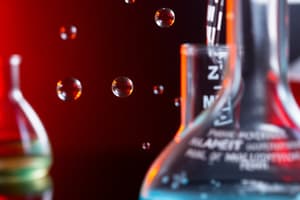Podcast
Questions and Answers
If you react 4 units of A with 10 units of B in the generic chemical equation 2A + 5B → C + 3D, what is true about the amounts of A and B?
If you react 4 units of A with 10 units of B in the generic chemical equation 2A + 5B → C + 3D, what is true about the amounts of A and B?
- The amounts of A and B are not specified.
- There are equivalent amounts of A and B. (correct)
- There are more units of A than B.
- There are more units of B than A.
How does a catalyst increase the rate of a reaction?
How does a catalyst increase the rate of a reaction?
- A catalyst increases the rate of reaction by lowering the activation energy. (correct)
- A catalyst does not increase the rate of reaction.
- A catalyst increases the rate of reaction by increasing the temperature.
- A catalyst increases the rate of reaction by increasing the activation energy.
What determines the number of protons in an element?
What determines the number of protons in an element?
- The number of neutrons determines the number of protons.
- An element's atomic weight determines the number of protons.
- An element's atomic number determines the number of protons. (correct)
- The number of electrons determines the number of protons.
What is the cause of ion-dipole interaction?
What is the cause of ion-dipole interaction?
What does the Big Bang Theory suggest about the origin of the universe?
What does the Big Bang Theory suggest about the origin of the universe?
What is the purpose of a bulking agent in a product?
What is the purpose of a bulking agent in a product?
What is the result of the process through which sunlight is converted into photovoltaic energy?
What is the result of the process through which sunlight is converted into photovoltaic energy?
What is the ability of an atom to attract electrons?
What is the ability of an atom to attract electrons?
What is necessary for successful collisions to occur?
What is necessary for successful collisions to occur?
What is the electronegativity difference between Hydrogen and Chlorine in Hydrochloric acid?
What is the electronegativity difference between Hydrogen and Chlorine in Hydrochloric acid?
What type of bond is formed between the two elements in Hydrochloric acid?
What type of bond is formed between the two elements in Hydrochloric acid?
What happens when the nonpolar end of a detergent molecule attracts the nonpolar oil molecules, while its polar end is attracted by the polar molecules of water?
What happens when the nonpolar end of a detergent molecule attracts the nonpolar oil molecules, while its polar end is attracted by the polar molecules of water?
Study Notes
Chemical Reactions
- A catalyst increases the rate of a reaction by lowering the activation energy.
- A limiting reactant determines how much product can be made.
- Collision theory states that effective collisions lead to chemical reactions.
- Increasing the temperature of the reactants increases the reaction rate.
- Favorable collision geometry and sufficient kinetic energy are necessary for successful collisions to occur.
Atomic Structure
- An element's atomic number determines the number of protons.
- An element's atomic weight determines the number of protons and neutrons.
Bonding
- Electronegativity is the relative ability of a bonded atom to attract shared electron pairs.
- A polar covalent bond is formed when there is an electronegativity difference between atoms, such as in hydrochloric acid (0.9).
- Ionic bonds are formed when there is a large electronegativity difference, such as in sodium chloride (2.1).
Intermolecular Forces
- Cohesive forces bring about capillary action between different molecules.
- Ion-dipole interaction occurs between an ion and a polar molecule.
- Attraction between molecules with similar polarities leads to dissolution.
Chemical Applications
- Surfactants, plasticizers, lather enhancers, fillers, and binders are ingredients in a cleaning agent.
- Lipase enzymes catalyze the hydrolysis of triglycerides to fatty acids and glycerol.
- Optical brighteners absorb ultraviolet rays and transmit them as blue light.
Energy and Physics
- The Big Bang Theory suggests that the universe began from a singularity and its expansion.
- In a hydroelectric power plant, electrical power can be generated by converting potential energy into kinetic energy.
Biochemistry
- Lipids are hydrophobic and do not mix with water, differing from other macromolecules.
- Proteins are used in living systems for chemical reactions, muscle movement, and structure formation.
- Organisms continuously create and break down proteins for various uses.
Studying That Suits You
Use AI to generate personalized quizzes and flashcards to suit your learning preferences.
Description
Test your knowledge on chemical reactions, catalysts, limiting reactants, and compound formation. Understand how reactants are consumed, and the role of catalysts in increasing reaction rates.



